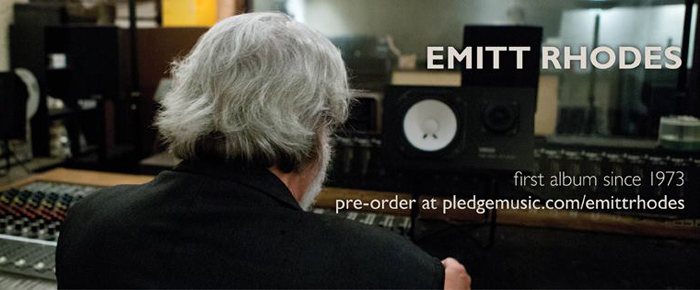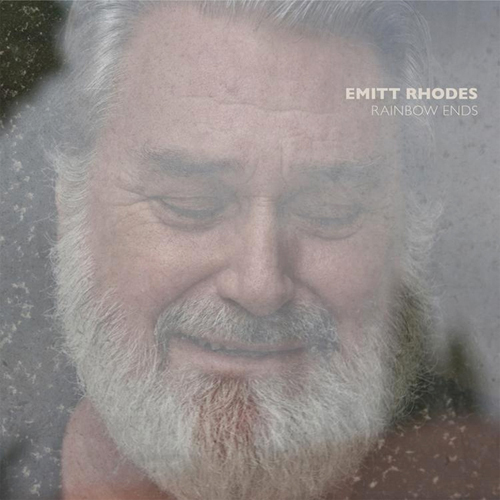
By Eleni P. Austin
Being a Rock & Roll wunderkind is tough business. Just ask Brian Wilson, or Michael Jackson. Early success and adulation is a heady cocktail, but the hangover can last decades.
Emitt Rhodes was born in Decatur, Illinois, but grew up in Hawthorne, California, 20 miles from Hollywood, the working class suburb also spawned the Beach Boys. By age 14, he was playing drums in a local band called the Emerals.
It was 1964 and Beatlemania was sweeping the country, so they became the Palace Guard. For a brief time they backed TV star Don Grady, (one of “My Three Sons”), before he moved on to Yellow Balloon. As soon as Emitt mastered the guitar he quit the Palace Guard, forming the Merry-Go-Round with his high school friend Gary Kato.
The pair managed to recruit a couple of heavy hitters, ex-Leaves bassist Bill Rinehart and drummer Joel Larson, who had just left the Grass Roots. Emitt wrote and sang all the songs, soon they were shopping a demo and signing with A&M Records. Their first single, “Live,” was a huge hit in L.A. and eventually peaked at #63 on the Billboard charts.
Their self-titled debut arrived in 1967. Thick with chiming guitars and cascading harmonies, it was a Baroque bridge between the Beatles and the Byrds. The record performed well locally, but never achieved the success afforded peers like Buffalo Springfield and Love.
In 1969, the band broke up, but they still owed some music to A&M. So Emitt completed a few unfinished Merry-Go-Round songs and created some new tracks. He recorded the album with Wrecking Crew pros like Larry Knechtel, Hal Blaine and Don Randi. Unfortunately, the label shelved the album. With his contractual commitment to A&M complete, he was free to sign with another record company.
Ultimately, Emitt inked a deal with ABC/Dunhill as a solo artist. He spent his $5,000 advance on recording equipment that he set up in his parents’ garage. Unsatisfied with his final A&M recordings, he opted for the one-man-band approach, teaching himself a plethora of unfamiliar instruments. The album was written and recorded on an old Ampex four-track recorder.
Emitt’s self-titled solo debut arrived in early 1970. Beautifully nuanced and hand-crafted, it fit in with recent releases from Harry Nilsson, Tim Buckley and Paul McCartney. Critics embraced the record, as did the music buying public; it peaked at #29 on the Billboard charts. The first single, “Fresh As A Daisy,” reached #54.
Not surprisingly A&M, looking to capitalize on the debut’s success, dusted off the album they had shelved the year before. They released it as American Dream. Certainly, its appearance confused consumers and siphoned sales, but it was clear that Emitt Rhodes was a prodigious talent, well on his way to Rock & Roll stardom.
Unfortunately, the contract Emitt signed with ABC-Dunhill required him to release a new album every six months. It seemed like an impossible demand for an artist who not only wrote and played every note himself, but also acted as producer and engineer on each track.
As work dragged on, his label suspended him and actually sued him for $250,000, (basically 50 times his advance), and withheld royalties. Recording dragged on, but Emitt delivered Mirror in 1971.
Although it wasn’t the effortless masterpiece of his debut, his sophomore album expanded his sonic palette, adding rougher textures on tracks like “Birthday Lady” and “Really Wanted You.” Again he received critical acclaim, but the album stalled at #182.
Legal disputes with his label continued to dog him, and his third album didn’t arrive until 1973. More pensive and less buoyant than previous efforts, Farewell To Paradise was still a wonderful record. But it was clear his protracted battle with ABC-Dunhill was taking its toll. Rather than continue to sacrifice his peace of mind, Emitt Rhodes walked away from the performing side of the music business. At the tender age of 24 he was done.
Initially he went to work for Elektra Records, engineering and recording other people’s music. He also recorded people in his home studio. He continued to write and record on his own, but that music wasn’t for public consumption.
In the ensuing decades, people began to discover (or rediscover) Emitt Rhodes genius. Like the band Big Star, he was an artist mostly revered by rock critics and record store clerks. His albums quickly went out of print, so his music became a rite of passage for the discerning few.
Mystery surrounded his legacy. Scraps of information (pre-internet), was passed around along with taped copies of his albums. Here was a brilliant singer-songwriter that the record industry just used, abused and threw away.
The Bangles offered a ringing version of the Merry-Go-Round song, “Live” on their full-length debut, All Over The Place, released in 1984. A year later Rhino released a greatest hits compilation from the band.
By the early 21st century, more compilations appeared, Daisy Fresh From Hawthorne, and Listen, Listen: The Best Of Emitt Rhodes. In 2001, Filmmaker Wes Anderson featured Emitt’s tender “Lullabye,” using it to score a poignant scene in his “Royal Tenenbaums” movie.
Five years later, musician/producer Chris Price met Emitt through a mutual friend. Although he was born a decade after Emitt quit recording, he had grown up in a musical family and was an ardent fan of his music. Chris had just signed a contract with Geffen Records and was hoping that Emitt would produce the album. Those plans never came to fruition, instead, a friendship blossomed.
Chris would occasionally play his music for Emitt, but was respectful of Emitt’s boundaries. When Emitt surprised him with lyric sheets and chord charts for about 20 songs, Chris convinced Emitt to let him produce the songs. They even recorded the songs in Emitt’s long-dormant Hawthorne studio.
 The result of those sessions is the return of Emitt Rhodes. Rainbow Ends is his first full-length record in 43 years. The album opens tentatively with the spare acoustic intro to “Dog On A Chain.”
The result of those sessions is the return of Emitt Rhodes. Rainbow Ends is his first full-length record in 43 years. The album opens tentatively with the spare acoustic intro to “Dog On A Chain.”
After four decades, Emitt’s sunny tenor is a little weathered, but still warm and inviting. As the full band kicks in, shang-a-lang guitar riffs connect with mellotron, clavinet and fluid organ fills. The lively melody and instrumentation belies a tale of woe and heartbreak; “I was led along like a dog on a chain, out in the cold out in the rain/I was led along like a dog on a leash, I did as told while she did as she pleased.”
Although it doesn’t feel like a concept record per se, the entire album is a song cycle charting the end of a relationship. Cracks and fissures begin to appear on both “This Wall Between Us” and “What’s A Man To Do.”
The melody of the former splits the difference between Fab Four grandeur and rustic Country Rock. Lush harmonies, peppery horns and a string section crest over a pummeling back beat and stinging guitar licks. This rich aural banquet underscores feelings of suspicion and foreboding; “I’m begging you to listen, I’m reaching out my hand/Come show me what I’m missing, help me understand.”
The latter is anchored by a loping rhythm, Fender Rhodes piano and ambient percussion. By now, the other shoe has dropped; “Time after time I’ve listened to her lie, time after time after time after time.” In the end, he must persevere, “No easy answer of this I’m sure, my life will change now I’m losing her/And though I’m scared, I’ll catch my breath, there’ll be no tears I have none left.”
Three songs inhabit the purgatory state between marriage and divorce. Post break-up, “Someone Else” cautiously dips a toe in the dating pool. The melody ricochets between quiet, diffident verses and rollicking choruses, as our hero suffers the slings and arrows of unrequited love.
On “I Can’t Tell My Heart” the thread of reconciliation is unraveling. A stormy piano ballad, it offers a potent combination of aching lyricism and a soaring melody. The vibe is vulnerable and emotionally naked, “When you love someone so much it hurts you, you learn to live with the pain/It’s a funny thing that happens, that I can’t explain.” His entreaties are buttressed by an incendiary guitar solo.
Finally, “It’s All Behind Us Now” offers some closure. A slinky charmer, the Latin Jazz-flavored melody is powered by a stop-start rhythm and phased, flange-y guitar. Here, the mood is relaxed, almost sanguine. It feels as though he let’s go of past indiscretions. “Let’s forget those things we said, say the things we wish we had/Let’s forget those things we did, do things right this time instead.”
The best tracks here sublimate the heartbreak. On “If I knew Then” the mien is defiant. This Jazzy shuffle is fortified by a leap-frog backbeat, spiky piano runs and muscular guitar breaks. In the end he vows “If I knew then what I know now I’d make amends, I’d change somehow/Wouldn’t give my heart to just anyone, if I knew then what was to come.”
Bathed in fluttery strings, thumping bass lines and a buttery slide guitar solo, “Isn’t It So” shares some soulful DNA with O.C. Smith’s “Little Green Apples.” It’s a spectral post-mortem, addressing the ghost of relationships past; “I’m still trying to please you even though you’re not here, Still talking to you even though you can’t hear.”
“Put Some Rhythm To It” is actually lighthearted and almost Happy-go-lucky. It’s a loping gambol, accented by blistering lead guitar and jaunty piano runs. The lyrics offer this sage piece of advice: “If you want to dance, if you want to find romance/All you gotta do is shake your ass and put some rhythm to it.”
The album closes with the title track. Forward looking and slightly optimistic, it’s powered by searching guitar chords, twinkly piano, woolly French Horn, mellotron and vibraphone accents plus a chugging backbeat. Despite recent romantic sturm und drang The future holds promise; “I wanna be somewhere in the sun, getting tan having fun/I wanna be with the ones I love, hold them close, give them hugs.” Hopefully this sunny destiny will include more music.
Rainbow Ends offers the same vibrant kaleidoscope of sound that colored Emitt’s early ‘70s music. But instead of operating as a one-man-band, a who’s who of players, back him here.
Once the word was out that he was recording, superstar fans were happy to lend a hand. This includes singer-songwriter Aimee Mann and multi- instrumentalists Jon Brion and Probyn Gregory. Roger Joseph Manning and Jason Faulkner from the Power Pop band Jellyfish, Nels Cline and Pat Sansone from Wilco, and Bangles front-woman Susannah Hoffs.
After a couple of rehearsals, the album was cut live, with the band in the room together, seven songs in one day, four the next. Of course, post-production was more painstaking. But the album manages the neat trick of sounding fresh and familiar at the same time.
It’s tempting to refer to Emitt Rhodes as the Rip Van Winkle or Howard Hughes of Rock & Roll, but that doesn’t tell the whole story. Turns out he’s been creating music all these years; he just waited until now to share it with the world.
At the tender age of 20 Emitt sang “I have to say the things I feel, I have to feel the things I say.” Happily, that musical philosophy has never wavered. Rainbow Ends is the first great record of 2016.












































